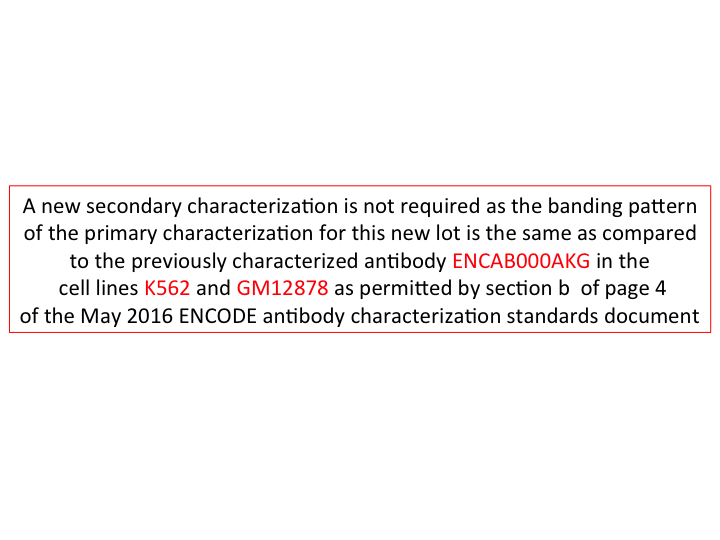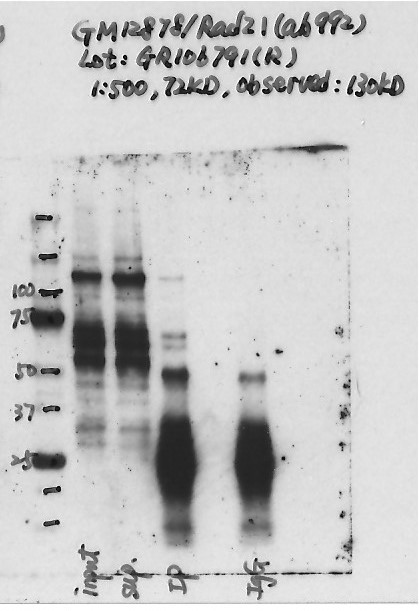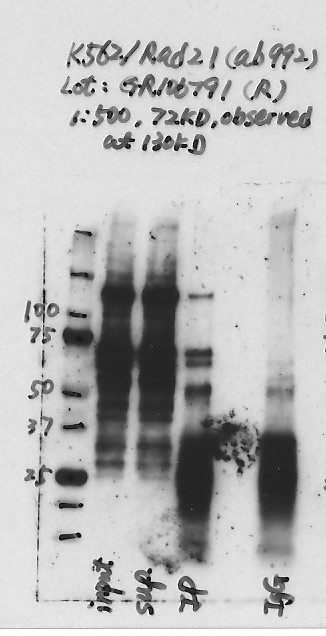ENCAB000BSF
Antibody against Homo sapiens RAD21
Homo sapiens
K562, GM12878, GM12892, GM19238, GM19240, GM12891, GM19239
characterized to standards with exemption
- Status
- released
- Source (vendor)
- Abcam
- Product ID
- ab992
- Lot ID
- GR106791
- Characterized targets
- RAD21 (Homo sapiens)
- Host
- rabbit
- Clonality
- polyclonal
- Purification
- affinity
- Isotype
- IgG
- Antigen description
- Synthetic peptide (Human) conjugated to KLH - which represents a portion of human Rad21 encoded within exon 14
- External resources
Characterizations
RAD21 (Homo sapiens)
exempt from standards
- Caption
- A new secondary characterization is not required as one exists for ENCAB000AKG which is a lot of the same antibody (ab992). The primary characterization (https://www.encodeproject.org/antibody-characterizations/2bf7eeee-2a31-46ba-956d-ecac94d65994/) of K562 for this lot shows the same banding pattern as the primary characterization (https://www.encodeproject.org/antibody-characterizations/a998bebe-57f7-4de9-8732-735fd07a8764) in K562 cell line for the lot ENCAB000AKG.
- Submitter comment
- This is a new lot of a previously characterized antibody ENCAB000AKG and we think no further characterization is necessary beyond the primary if the banding pattern is consistent with the old.
- Reviewer comment
- The banding pattern in GM12878 and K562 is consistent with that of the primary characterizations associated with old lot ENCAB000AKG so a new secondary characterization for the new lot is not needed.
- Submitted by
- Jessika Adrian
- Lab
- Michael Snyder, Stanford
- Grant
- U54HG006996
- Download
- ENCAB000BSF_secondary.png
RAD21 (Homo sapiens)
GM12878GM12892GM19238GM19240GM12891GM19239
compliant
- Caption
- Immunoprecipitation was performed on nuclear extracts from the cell line: GM12878, using the antibody ab992. The blot shows western blot analysis of input, flowthrough, immunoprecipitate and mock immunoprecipitate using IgG. Molecular Weight: 71.69, band observed at 130KD
- Submitter comment
- This is the same banding pattern found in ENCAB529YRC and ENCAB770AFW and ENCAB000AKG. While the predicted size of Rad21 is ~72kD, according to product characterization literature (found at manufacturer's website), the bands at ~70kD are of unknown origin while a band of ~140kD, similar to the one observed here, is identified as Rad21. In support of this, siRNAs targeting Rad21 dramatically reduce levels of the 140kD band, while levels of the 70kD band are unaffected (see Figure 2 of this document). 1. Hyperphosphorylation (ref. PMID 11073952 & many others) https://www.ncbi.nlm.nih.gov/gene/5885 2. Dimerisation as part of cohesin complex (whose other members we can detect in the 130kDa band, refs. PMIDs 23874961 & 19075111)
- Reviewer comment
- Multiple bands and band at expected size not >50% of total signal in lane. Peggy Farham has said that one GM is equivalent to all GM cell lines so that if you characterized in one line, all lines are considered characterized.
- Submitted by
- Nathaniel Watson
- Lab
- Michael Snyder, Stanford
- Grant
- U54HG006996
- Download
- GM12878-Rad21.jpg
RAD21 (Homo sapiens)
K562
compliant
- Caption
- Immunoprecipitation was performed on nuclear extracts from the cell line: K562, using the antibody ab992. The blot shows western blot analysis of input, flowthrough, immunoprecipitate and mock immunoprecipitate using IgG. Molecular Weight: 71.69, band observed at 130KD
- Submitter comment
- The banding pattern here is the same as found in ENCAB770AFW and ENCAB000AKG and ENCAB529YRC. While the predicted size of Rad21 is ~72kD, according to product characterization literature (found at manufacturer's website), the bands at ~70kD are of unknown origin while a band of ~140kD, similar to the one observed here, is identified as Rad21. In support of this, siRNAs targeting Rad21 dramatically reduce levels of the 140kD band, while levels of the 70kD band are unaffected (see Figure 2 of this document). 1. Hyperphosphorylation (ref. PMID 11073952 & many others) https://www.ncbi.nlm.nih.gov/gene/5885 2. Dimerisation as part of cohesin complex (whose other members we can detect in the 130kDa band, refs. PMIDs 23874961 & 19075111)
- Submitted by
- Nathaniel Watson
- Lab
- Michael Snyder, Stanford
- Grant
- U54HG006996
- Download
- K562-Rad21.jpg


